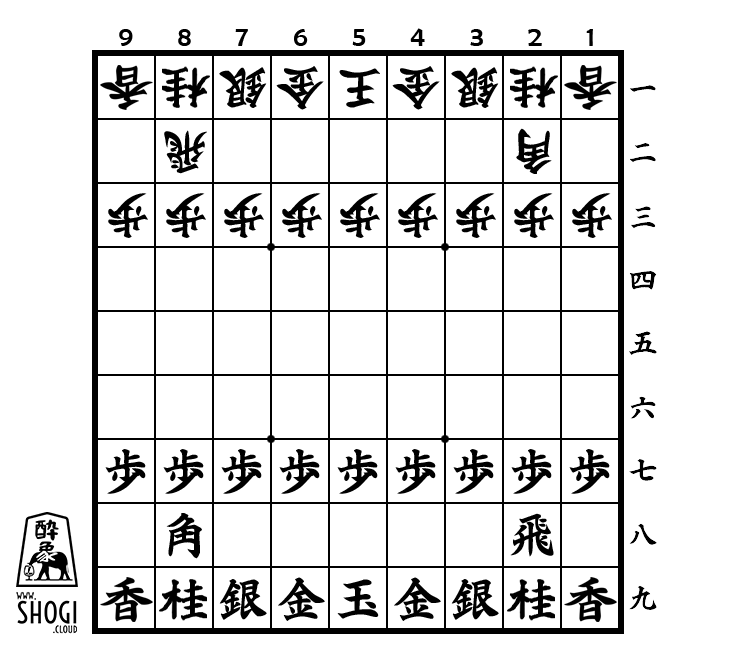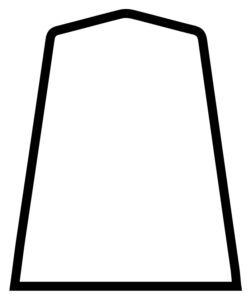italiano
Pezzi dello Shogi
Ad inizio partita, i giocatori hanno a disposizione venti pezzi ciascuno.
Sullo shogiban trovano posto quaranta pezzi.
I komadai sono vuoti.
Non esistono pezzi bianchi e neri. Il giocatore di maggior valore, il più anziano o il maestro usa Osho. Il giocatore di minor valore, il più giovane o l’allievo usa il Gyokusho.
Il giocatore che muove per primo viene sorteggiato.
Sente è il giocatore che muove per primo. Gote muove per secondo.
italiano
Forma e colore
I pezzi (koma) hanno la forma di un pentagono leggermente allungata.
La base del pentagono è rivolta verso il proprietario. La punta è rivolta verso l’avversario.
I pezzi non hanno colore perchè possono essere catturati e riutilizzati dall’avversario.
Il nome del pezzo viene scritto con uno o due kanji al centro del pezzo. I pezzi possono essere promossi. Il nome del pezzo promosso è scritto sul retro dello stesso pezzo. Alcuni set di pezzi usano il colore rosso per riconoscere il nome promosso. La promozione avviene girando il pezzo.
Osho, Gyokusho e Kinsho non possono essere promossi.
Non è necessario saper leggere i kanji ma è sufficiente riconoscerli come fossero disegni.
english
english
Shogi pieces
At the beginning of the game, each player has twenty pieces.
The shogiban accommodates forty pieces.
The komadai is empty.
There are no white and black pieces. The player of higher rank, the elder, or the master uses Osho. The player of lower rank, the younger, or the apprentice uses Gyokusho.
The player who moves first is determined by a draw.
Sente is the player who moves first. Gote moves second.
english
Shape and color
The pieces (koma) have a slightly elongated pentagonal shape.
The base of the pentagon faces the owner, while the tip faces the opponent.
Pieces have no color because they can be captured and reused by the opponent.
The name of the piece is written with one or two kanji characters in the center of the piece. Pieces can be promoted, and the name of the promoted piece is written on the back of the same piece. Some sets of pieces use the color red to identify the promoted name. Promotion is done by flipping the piece.
Osho, Gyokusho, and Kinsho cannot be promoted.
Knowing how to read kanji is not necessary; recognizing them as if they were drawings is sufficient.
日本語
日本語
駒
ゲームの開始時、各プレイヤーは駒を20個ずつ持っています。
将棋盤には40個の駒が収められます。
駒台は空です。
白と黒の駒は存在しません。高位のプレイヤー、年長者、または師匠は王将を使用します。低位のプレイヤー、若者、または弟子は玉将を使用します。
最初に動くプレイヤーはくじ引きで決まります。
先手が最初に動くプレイヤーで、後手が2番目に動きます。
日本語
形と色
駒(こま)はやや細長い五角形の形状をしています。
五角形のベースは所有者の方を向いており、先端は相手の方を向いています。
駒には色はついていません。なぜなら、相手によって捕獲され再利用される可能性があるためです。
駒の名前は、駒の中央に一つまたは二つの漢字で書かれています。駒は昇進することができ、昇進した駒の名前は同じ駒の裏に書かれています。一部の駒セットでは昇進した名前を識別するために赤色を使用しています。昇進は駒を裏返すことで行われます。
王将(おうしょう)、玉将(ぎょくしょう)、金将(きんしょう)は昇進できません。
漢字を読むことは必要ありませんが、それらを図として認識するだけで十分です。
Koma hub
駒 • こま • koma
王
将
駒 • こま • koma
圭
駒 • こま • koma
杏


